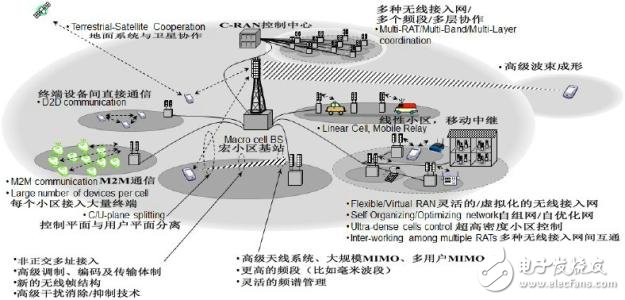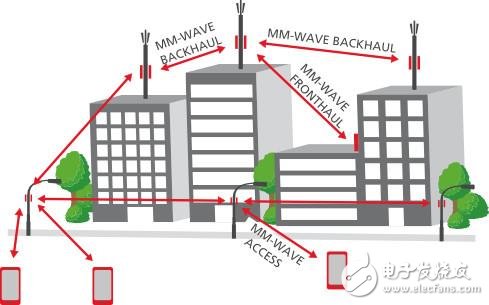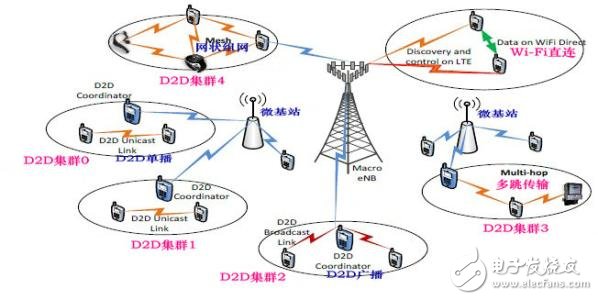An electromagnetic wave having a wavelength of from 10 mm to 1 mm and a frequency of from 30 GHz to 300 GHz is called a millimeter wave, and a method of communicating using a millimeter wave is called millimeter wave communication. Millimeter wave communication is divided into two categories: millimeter wave waveguide communication and millimeter wave radio communication. Generally, the millimeter wave band refers to 30 GHz to 300 GHz, and the corresponding wavelength is 1 mm to 10 mm. Millimeter wave communication refers to communication using millimeter waves as a carrier for transmitting information. Most of the current application research focuses on several "atmospheric window" frequencies and three "attenuation peak" frequencies. 1) is a typical line of sight transmission The millimeter wave belongs to the very high frequency band, and it propagates in space in the form of direct waves. The beam is narrow and has good directivity. On the one hand, since the millimeter wave is heavily affected by atmospheric absorption and rainfall fading, the single-hop communication distance is short; on the other hand, because the frequency band is high and the interference source is small, the propagation is stable and reliable. Therefore, millimeter wave communication is a typical communication technology with a high quality, constant parameter wireless transmission channel. 2) has "atmospheric window" and "attenuation peak" The "atmospheric window" refers to the 35 GHz, 45 GHz, 94 GHz, 140 GHz, and 220 GHz frequency bands, and the millimeter wave propagation is less attenuated near these special frequency bands. In general, the “Atmospheric Window†band is more suitable for point-to-point communication and has been adopted by low-altitude air-to-ground missiles and ground-based radars. The attenuation near the 60 GHz, 120 GHz, and 180 GHz bands has a maximum value of about 15 dB/km or more, which is called an "attenuation peak." Often these "attenuation peak" bands are preferred by multi-channel concealed networks and systems to meet the network safety factor requirements. 3) The attenuation is severe during rainfall Compared with microwaves, millimeter-wave signals are much more attenuated under harsh climatic conditions, especially during rainfall, which seriously affects the propagation effect. The conclusion of the study is that the attenuation of millimeter wave signal rainfall is closely related to the instantaneous intensity of rainfall, the length of the distance and the shape of the raindrop. Further verification shows that under normal circumstances, the greater the instantaneous intensity of rainfall, the farther the distance, the larger the raindrops, the more severe the attenuation. Therefore, the most effective way to deal with rainfall attenuation is to leave enough level attenuation margin when designing a millimeter-wave communication system or communication line. 4) Strong penetration of dust and smoke Atmospheric lasers and infrared light have poor penetration into sand and smoke, and millimeter waves have a clear advantage at this point. A large number of field tests have shown that millimeter waves have a strong penetrating power for dust and smoke, and can pass sand and smoke almost without attenuation. Even under the conditions of higher intensity scattering caused by explosions and metal foil strips, even if fading occurs, it is short-lived and will recover quickly. As the ions diffuse and fall, they do not cause severe disruption of millimeter wave communication. Current millimeter wave communication systems mainly include point-to-point communication on the earth and communication or broadcasting systems via satellite. Point-to-point millimeter-wave communications on Earth are now commonly used in relay communications where privacy is critical. The millimeter wave itself has strong concealment and anti-interference. At the same time, due to the attenuation of the millimeter wave in the atmosphere and the use of a small-diameter antenna, a very narrow beam and a small side lobes can be obtained, so the interception of millimeter wave communication is obtained. And interference becomes very difficult. 1, millimeter wave ground communication The traditional application of millimeter-wave terrestrial communication systems is relay (relay) communication. Numerous tests of millimeter wave propagation have shown that multi-hop millimeter wave relay (relay) communication is feasible. In order to reduce the risk, we start with the low end of the millimeter wave band and the high end of the centimeter wave band. At the same time as the development of high-band and large-capacity communication systems, medium- and low-capacity short-range millimeter-wave communication devices in higher frequency bands have also been introduced. By the 1990s, there was a wave of global informationization. With the rapid development of the Internet, the rapid growth of interactive multimedia services, broadband video services, and private network and radio communication, there is an urgent need to increase transmission rate, transmission bandwidth, and transmission quality. The demand for broadband access has become increasingly strong, and the development of various broadband access networks and devices has been promoted. Wireless broadband access technologies using millimeter waves have emerged. 2, millimeter wave satellite communication Due to the abundant frequency resources, millimeter wave communication has been rapidly developed in satellite communication. For example, in the interstellar communication, the 5mm (60GHz) band is generally used because the atmospheric loss is extremely large at this frequency, and the ground cannot detect the interstellar communication content. In the interstellar space, because the atmosphere is extremely thin, it will not cause the signal to decline. The US "tactical, strategic, and relay satellite systems" is an example. The system consists of five satellites with an upstream frequency of 44 GHz, a downstream frequency of 20 GHz, a bandwidth of 2 GHz, and an interstellar communication frequency of 60 GHz. The main advantages of satellite communications compared to other modes of communication are: a) The communication distance is long, and the cost of establishing the station has nothing to do with the communication distance. b) Work in broadcast mode to facilitate multiple access. c) The communication capacity is large, and there are many types of services that can be transmitted. d) can be spontaneous, self-receiving, monitoring, etc. In the 1970s and 1980s, satellite communications were mostly carried out using geostationary orbits (also known as synchronous orbits). After the 1990s, satellite communication systems using medium and low orbits were coming. However, in the case of large-capacity communication services, satellite communication systems using geostationary orbit are still the protagonists. According to statistics, in the 10 years of the 1990s, as many as 200 communication satellites were launched into the orbit, with the C-band being the most and the Ku-band being the second. The resulting congestion of satellite communications spectrum has become increasingly prominent, and the move to higher frequency bands has become an inevitable trend. In fact, experimental research on millimeter-wave satellite communications began in the early 1970s. Much of the development work in this area has taken place in the United States, the former Soviet Union and Japan. In the late 1980s and 1990s, in addition to the introduction of a wider range of more widely used millimeter-wave band experimental satellites, a practical Ka-band satellite communication system began to emerge. It should be noted that many of these satellites use a range of advanced technologies, including multi-beam antennas, on-board switching, on-board processing, and high-speed transmission. 3. Application of millimeter wave communication in electronic countermeasures Military needs are an important factor in promoting the development of millimeter-wave systems. At present, millimeter waves have been widely used in radar, guidance, tactical and strategic communication, electronic countermeasures, remote sensing, and radiation measurement. Among them, strategic communication and electronic countermeasures are very important application directions. Electronic confrontation refers to the electromagnetic struggle between both hostile parties using electronic equipment or equipment, and is an important means in modern warfare. With the development of millimeter wave radars and guidance systems, corresponding electronic countermeasures have also developed. In addition to strong firepower and high density in modern warfare, an important feature is that the entire battle is carried out in intense electronic confrontation. Therefore, communication equipment is required to have strong anti-interference ability, and millimeter wave shows a clear advantage in this respect. For example, the selection of ship-to-ship millimeter-wave communications in the three "attenuation peak" bands of 60 GHz, 120 GHz, and 200 GHz, using the characteristics of severe attenuation of signals in these bands, can greatly improve the anti-jamming and anti-jamming of ship-to-ship communication. Interception ability. In foreign countries, the development of electronic countermeasure devices such as direction finding machines, jammers and signal analyzers in the millimeter wave band has been vigorously carried out. The millimeter wave beam is very narrow, and the side lobes of the antenna can be made very low, making reconnaissance and active interference more difficult. Therefore, passive interference has a great development in the millimeter wave band. For millimeter waves below 35 GHz, the most common means of interference is to place non-resonant millimeter-wave chaffs and aerosols to scatter the enemy millimeter-wave radar beam, which can interfere with a wider frequency band without having to accurately measure the enemy radar in advance. Frequency of. In addition, it is also possible to use a plasma generated by explosion, thermal ionization or radioactive elements to absorb and scatter millimeter waves to interfere with enemy radar. The frequency coverage of most active radar reconnaissance and warning systems has been extended to 0.5 GHz to 40 GHz. According to reports, part of the radar reconnaissance equipment in the US electronic countermeasures equipment can reach 110 GHz and is developing to 300 GHz. The frequency of radar warning equipment has been extended to 40 GHz to 60 GHz. NATO is developing a vehicle-mounted millimeter-wave warning device with a frequency range of 40 GHz to 140 GHz. In addition, the communication reconnaissance band covers the 10 GHz-mm band, and the communication interference portion of 40 GHz or less has been put into practical use and is developing to 110 GHz. Stealth technology can also be utilized in the millimeter band. When dealing with an active millimeter-wave radar, as in the microwave band, it is possible to reduce the shape of the radar cross-section or apply a millimeter-wave absorbing material such as ferrite to the surface to reduce the intensity of the reflected wave. For a passive radar that tracks the target by detecting the contrast between the low-millimeter-wave radiation of the metal target and the background radiation, a target with a strong millimeter-wave radiation is applied to make the radiation and background radiation substantially equal. Thereby merging the target into the background. In short, millimeter wave communication is very necessary and significant for military applications. It is a promising communication means with narrow beam, high data rate, concealed radio waves, good confidentiality and anti-interference performance, rapid opening and easy to use. Flexible and all-weather work. In addition to its application in the field of electronic countermeasures, the application of military millimeter wave communication includes far (outer space) near (atmosphere) distance communication, rapid emergency communication, submarine communication, satellite communication, interstellar communication, and the way down the microwave trunk line. Cable interruption rushing device, etc. Millimeter wave communication technology is a typical dual-use technology. In the military field, it can be applied to inter-satellite communication or relay, millimeter wave frequency band secret communication and millimeter wave enemy and foe identification system; in the civilian field, it can be applied to broadband multimedia mobile communication system, measurement radar, vehicle and ship collision avoidance, topographic mapping , radio astronomy, interactive large-capacity television broadcasting and satellite millimeter wave link system and many other aspects, and will further expand its market. In short, a large amount of research work has been carried out in the field of domestic and foreign millimeter wave communication, covering everything from basic communication theory to practical system application, which fully demonstrates that millimeter wave communication is a promising wireless communication technology. . Oil Filter For MAZDA MAZDA Oil Filter Replacement,Oil Filter For MAZDA Cars,MAZDA Car Oil Filter,MAZDA Auto Oil Filter Zhoushan Shenying Filter Manufacture Co., Ltd. , https://www.renkenfilter.com


